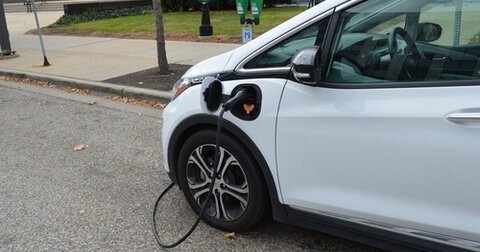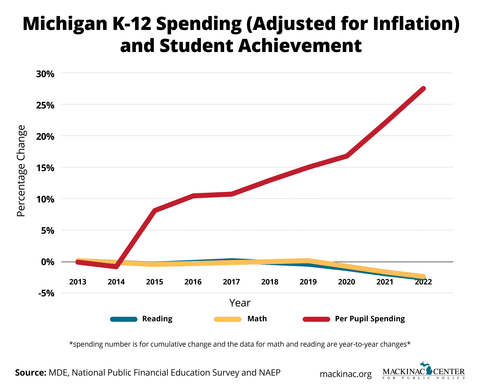Drive less, use less energy, switch to electric vehicles, says Grand Rapids climate action plan
Plan aims to reduce emissions by 85% by 2030 and 100% by 2040
Michigan’s second-largest city wants its residents to drive less, switch to electric vehicles, and use less energy, according to its 95-page draft of a climate action and adaption plan.
The city of Grand Rapids’ climate plan uses the amount of greenhouse gases emitted by municipal operations in 2008 as its benchmark, setting a goal to reduce their emissions by 85% by 2030 and 100% by 2040.
The plan will try to reduce community greenhouse gas emissions by 62.8% per capita by 2030, with 2019 as the benchmark. The plan has six chapters: energy (more solar use), healthy homes (less electric use; income-based electric rates), commercial buildings (less energy use), transportation (more carpooling and cycling, denser developments), natural systems (more trees and rain gardens), and food systems (more urban agriculture and composting, less food in trash).
City residents create emissions by heating their homes and businesses, driving for work and the family, and going shopping.
The three largest sources of emissions are buildings (40%, with single and multifamily residential accounting for 28% and commercial buildings accounting for 11% of the total), the transportation sector (30%, with gasoline-powered vehicles accounting for 18%), and industrial facilities (25%). Commercial energy, solid waste, upstream impacts, and other factors account for the remaining emissions (about 17%).
More than half of public comments on the draft opposed one or more of its six chapters, Michigan Capitol Confidential previously reported.
The draft plan calls for reducing by 80% the carbon dioxide created by the electric grid by 2030, reducing vehicle miles traveled by 10% by 2030, boosting electric vehicle adoption by 4.5% annually, and increasing the number of miles traveled in electric vehicles by 22.5% by 2030.
“While electrification of vehicles is needed to reduce emissions in the transportation sector, electric vehicle options are often more expensive, less accessible, reinforce traditional single occupancy vehicle usage, and pose potential waste and safety issues,” the draft said.
The plan aims to retire the city fleet and replace it with electric vehicles, pilot a city e-bike fleet with charging infrastructure, and train or hire specialized technicians to service city fleet EVs.
Buildings should use less energy, the plan says. For 10% of all existing commercial buildings, the plan aims to reduce energy use by 20% annually and move 5% of existing commercial buildings annually from gas to electric heating.
The plan aims for 5% of all existing residential buildings to reduce energy use by 20%. It also calls for all new residential buildings and 1% of existing buildings to meet the International Energy Conservation Code 2018, and for all new residential buildings and 11% of existing buildings to switch to electric heat each year.
Grand Rapids is accepting feedback on the climate action plan through Feb. 17.
Cities with more trees and vegetation tend to have milder temperatures and better air quality, said Jason Hayes, director of energy and environmental policy at the Mackinac Center for Public Policy. “Replacing non-native grasses with native species and reducing impervious surfaces, also recommended in the chapter on natural systems, helps decrease demands on water and sewage infrastructure.”
The energy chapter, however, encourages the use of solar power, “an expensive and unreliable energy source often linked to coal-powered electricity, stolen intellectual property, and the labor of imprisoned Uyghurs in Chinese labor camps,” Hayes wrote in an email.
The chapter on housing suggests that the city advocate for affordable electricity rates, but Michigan is pursuing net-zero emissions by 2050. Mackinac Center research shows that statewide net-zero mandates will raise the average monthly residential electricity bill from $118 in 2022 to between $180 and $290 by 2035.
This increased electricity cost will hurt commercial businesses and residents and will increase their monthly electricity bills by 53% to 146% by 2035, Hayes said.
The chapter on food supports more urban agriculture, but that undermines the stated goal of reducing greenhouse gas emissions, Hayes said.
”Fruits and vegetables grown in urban farms and gardens have an average carbon footprint six times greater than that of conventionally produced produce,” a 2024 University of Michigan study concluded.
“Instead of squandering time and limited tax dollars on ineffective climate programs,” Hayes wrote, “city officials in Grand Rapids would better serve taxpayers and residents by concentrating on fundamental issues: crime prevention, reliable and affordable utility services (water, sewer, and garbage), road maintenance, and education.”
Michigan Capitol Confidential is the news source produced by the Mackinac Center for Public Policy. Michigan Capitol Confidential reports with a free-market news perspective.


 State climate conference to tout clean energy plans that will raise electricity costs
State climate conference to tout clean energy plans that will raise electricity costs
 Feedback mostly opposes Grand Rapids climate plan
Feedback mostly opposes Grand Rapids climate plan
 Grand Rapids seeks feedback on climate action plan
Grand Rapids seeks feedback on climate action plan


 Michigan pushes $762M pre-K expansion while K-12 performance declines
Michigan pushes $762M pre-K expansion while K-12 performance declines
 Michigan spends $6.9M advertising 'cost-free' pre-K
Michigan spends $6.9M advertising 'cost-free' pre-K
 Michigan Education board member claims funding cuts after record funding
Michigan Education board member claims funding cuts after record funding